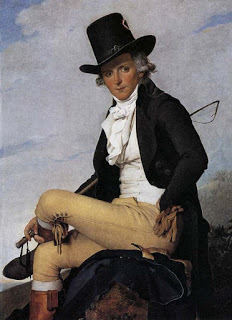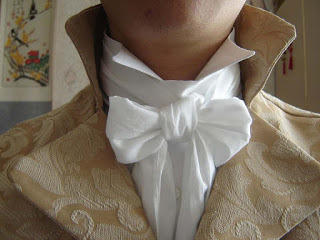The Neckcloth Part 1
 David, Pierre Sériziat, 1795
Loretta reports:
David, Pierre Sériziat, 1795
Loretta reports:Not very long ago, a reader who’d happened upon Susan’s post about 18th C men’s shirts , asked what an English gentleman’s stock was made of, saying, “In painting of the era it seems to be of a very light material as there are multiple folds.”
I brought the question to Mark Hutter , Master Taylor in Colonial Williamsburg’s Historic Trades Department.
The answer, as is the case so often with fashion, is, “It depends.” But he did clarify further, as well as guiding me toward several resources for my investigation. A gentleman’s choice of fabric to put around his neck would depend on the time period as well as the occasion, his bank account, and his personal taste. As Mark pointed out to a visitor, there’s no “typical.”
Because it’s a huge subject, I’m picking one era, place, and financial situation, the one in my stories: early 19th C British gentlemen of the upper classes.
According to Ian Kelley’s Beau Brummell , the dandy’s neckcloth was “a triangle of fine Irish muslin, cut diagonally from a square yard and plainly seamed.” From what I can ascertain, fine Irish muslin would have been quite expensive.
 Regency style neckcloth
Regency style neckcloth
It gets tricky, distinguishing between cotton and linen fabrics. Undergarments like shirts, neckcloths, collars would be referred to as “linen,” though they might be made of other material. Good cotton, however, as far as I can discover, wasn’t cheap. The famous muslin dresses Regency ladies wore were made of fabric imported from India, and like their miles-long cashmere shawls, displayed their wealth.
Mark mentioned lawn and cambric, terms some of our readers might have come across in their reading. According to Harmuth’s Dictionary of Textiles, lawn is “a plain woven, very light, soft, smooth and sheer cotton or linen wash dress goods ... similar to cambric but lighter.” Irish lawn is “very fine, plain woven, bleached lawn, made of pure, hard-spun ply linen yarn.”
To answer the reader’s question, then, the neckcloths in the portraits were of quite fine material, most likely of linen or muslin. The white neckcloth* we see so often in Regency portraits would have been lightly starched to allow one to create the correct folds. Too much starch would make it too stiff. Usually. A few styles, it turns out, demanded stiffer fabric. But that’s another topic.
In the next post, we’ll take a look at the incredibly tricky business of tying these things.
*They came in other colors, as well as in silk, but we’ll deal with that later, too. Eventually.
Image: Jacques-Louis David, Portrait of Pierre Sériziat , 1795, Louvre Museum
English: A Regency style neckcloth tied in a bow on a starched Grafton collar . Attribution: CharlieHuang at English Wikipedia
Clicking on the image will enlarge it. Clicking on the caption will take you to the source, where you can learn more and enlarge images as needed.
Published on April 11, 2018 21:30
No comments have been added yet.



